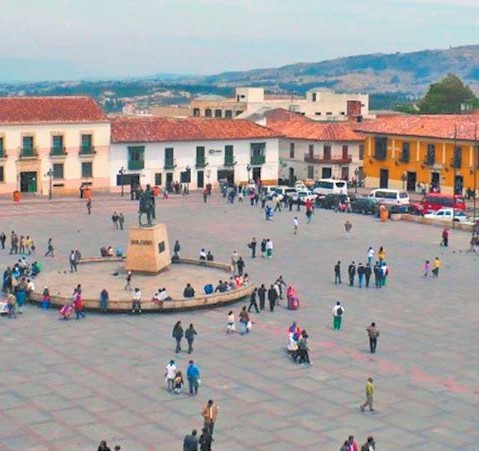Present of the historical centers. A local sigh
Main Article Content
Abstract
This article is the producto of a reflection of the reality being experienced by our historic sites, especially the historical center of the city of TUnja, capital of the departamente on Boyacá. Under this perspective is a description of the process that led from the regulatory point of view regarding the regulation, protection and funding of historic centers, where they have adopted different policies that have generated consequences of varios kinds, the which are described in order to indentify the pros and cons of them, in this way to get to figure out viable and sustainable poposals from the economic point of view to finance projects in the historic center, and refer to the historical center as a large urban project GPU. The aim of thes papaer is to give the reader an overview on the issue raised and to call attention to the relevance of starting a reflection of the relationship between different aspects to consider achieving true sustainability of our town centers.
Article Details
Section
Artículos
References
Alcaldía de Tunja. (2012). Obtenido de Alcaldía de Tunja. Recuperado el 03 04 2017. Sitio web: http://www.tunja-boyaca.gov.co/Nuestros_ planes.shtml?apc=gbPlanes%20Iocales%20 ( comunas, %20corregimientos)-1-&x=2014
Alcaldía de Tunja. (2017). Informe Alcaldía de Tunja. Recuperado el 30 12 2017. Sitio Web: http:// www. tunj a-boya ca. gov.co/ apc-aa/vi ew. php3?vid=1090&cmd[1090]=x-1090-39033
Bergel, S. {2001). Reconfiguración social y espacial en el área metropolitana 1991-1999. Ponencia presentada al VI Seminario Internacional de la Red Iberoamericana de Investigación {RII), sobre Globalización y Territorio, realizado en Rosario Argentina, mimeo, 25p.
Martínez, B., & Aguilar, M. {2007). Movilidad, ambiente y centros históricos: Una reflexión a propósito del sector de la candelaria, Bogotá. Investigación Volumen 10 No. 3 Diciembre de 2007., 119-132.
United Nations educational, Scientific and Cultural Organization . (13 de 02 de 2017). UNESCO. Obtenido de UNESCO : https://whc.unesco. org/es/list/
Carrizosa, J. {1990). La sostenibilidad de la ciudad. Torres, Carlos et al. La ciudad: hábitat de diversidad y complejidad, 59, 63,64.
Congreso de Colombia. {1959). Función pública. Recuperado el 30 12 2017. Sitio web: http://www. funcionpubl ica. gov. co/ eva/ gestornormativo/norma.php?i=326
Corporación centinelas de Tunja. {2011). Corporación centinelas de Tunja. Recuperado el 30 12 2017. Sitio Web: http:// centinelasdetunja.com/cct/2017 /05/05/
Corporación centinelas de Tunja. (2011). Corporación centinelas de Tunja. Recuperado el 30 12 2017. Sitio Web: http:// centinelasdetunja.com/cct/2017 /05/05/
Gómez, C. F. {2018). Los tesoros no pueden seguir escondidos. Recuperado el 12 10 2018. Sitio Web: http://www.periodicoeldiario. com/2018/08/25/los-tesoros-no-puedenseguir-escondidos/
Guzmán, Á. l. {1987). Poblamiento y urbanismo colonial en Santander. Bogotá. Recuperado el 12 30 2017. Sitio Web: https://books. openedition.org/ifea/2094?Iang=es
Universitat de Barcelona. {2011). Universitat de Barcelona. Recuperado el 30 12 2017. Sitio Web: http://www.ub.edu/web/ub/ca/
Wiki laves monuments in Colombia. {2012). Wiki loves monuments in Colombia. Recuperado el 30 12 2017.
Sitio Web: https://tools.wmflabs.org/ wikiloves/images?event=monuments&year= 2012&country=Colombia&start=2801
Alcaldía de Tunja. (2017). Informe Alcaldía de Tunja. Recuperado el 30 12 2017. Sitio Web: http:// www. tunj a-boya ca. gov.co/ apc-aa/vi ew. php3?vid=1090&cmd[1090]=x-1090-39033
Bergel, S. {2001). Reconfiguración social y espacial en el área metropolitana 1991-1999. Ponencia presentada al VI Seminario Internacional de la Red Iberoamericana de Investigación {RII), sobre Globalización y Territorio, realizado en Rosario Argentina, mimeo, 25p.
Martínez, B., & Aguilar, M. {2007). Movilidad, ambiente y centros históricos: Una reflexión a propósito del sector de la candelaria, Bogotá. Investigación Volumen 10 No. 3 Diciembre de 2007., 119-132.
United Nations educational, Scientific and Cultural Organization . (13 de 02 de 2017). UNESCO. Obtenido de UNESCO : https://whc.unesco. org/es/list/
Carrizosa, J. {1990). La sostenibilidad de la ciudad. Torres, Carlos et al. La ciudad: hábitat de diversidad y complejidad, 59, 63,64.
Congreso de Colombia. {1959). Función pública. Recuperado el 30 12 2017. Sitio web: http://www. funcionpubl ica. gov. co/ eva/ gestornormativo/norma.php?i=326
Corporación centinelas de Tunja. {2011). Corporación centinelas de Tunja. Recuperado el 30 12 2017. Sitio Web: http:// centinelasdetunja.com/cct/2017 /05/05/
Corporación centinelas de Tunja. (2011). Corporación centinelas de Tunja. Recuperado el 30 12 2017. Sitio Web: http:// centinelasdetunja.com/cct/2017 /05/05/
Gómez, C. F. {2018). Los tesoros no pueden seguir escondidos. Recuperado el 12 10 2018. Sitio Web: http://www.periodicoeldiario. com/2018/08/25/los-tesoros-no-puedenseguir-escondidos/
Guzmán, Á. l. {1987). Poblamiento y urbanismo colonial en Santander. Bogotá. Recuperado el 12 30 2017. Sitio Web: https://books. openedition.org/ifea/2094?Iang=es
Universitat de Barcelona. {2011). Universitat de Barcelona. Recuperado el 30 12 2017. Sitio Web: http://www.ub.edu/web/ub/ca/
Wiki laves monuments in Colombia. {2012). Wiki loves monuments in Colombia. Recuperado el 30 12 2017.
Sitio Web: https://tools.wmflabs.org/ wikiloves/images?event=monuments&year= 2012&country=Colombia&start=2801

